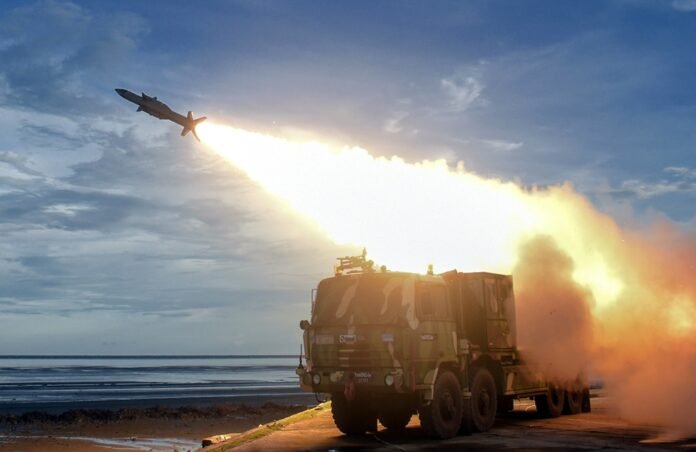New Delhi: In a major boost to the country’s strategic firepower, India successfully test fired three major missiles within a span of 24 hours – Prithvi-II, Agni-I and Akash Prime with the last named being a new hypersonic missile called the Extended Trajectory Long Duration Hypersonic Cruise Missile (ET-LDHCM), developed under the Defence Research and Development Organisation’s (DRDO) Project Vishnu, which significantly outpaces and outdistances the current BRAHMOS cruise missile and was tested in Ladakh.
The ET-LDHCM can travel eight times the speed of sound. It can strike targets 1,500 kilometres away. This test comes amid global tensions. India is accelerating its defence modernisation. The missile is designed for stealth, precision, and flexibility.
On July 16, the Army successfully test-fired the upgraded Akash Prime missile in the high-altitude terrain of Ladakh, at an elevation of over 4,500 metres (15,000 ft). This marks a significant achievement, as few air defence systems are tested in such extreme conditions marked by low oxygen and high winds.
India also successfully test-fired Prithvi-II, Agni-I missiles, validating key operational parameters. The tests mark a boost to India’s nuclear and air defence capabilities.
The successful test firing of three major missile systems within a span of 24 hours, underscores a significant boost to its strategic firepower. The tests included the nuclear-capable short-range ballistic missiles Prithvi-II and Agni-I, as well as the advanced surface-to-air missile system, Akash Prime. This development follows India’s recent success in Operation Sindoor, where the Akash system played a key role in intercepting Chinese drones and Turkish air platforms deployed by Pakistan.
Akash Prime is an enhanced version of the original Akash system. It is capable of neutralising threats such as fighter jets, cruise missiles, and drones at a range of 30-35 kilometres and an altitude of 18-20 kilometres. The system integrates a radar (Rajendra), command-and-control unit, and missile launcher, enabling multi-layered defence. During the trial, it successfully intercepted two high-speed drones. A key advancement is its indigenously developed Radio Frequency Seeker, which tracks aerial targets and guides the missile with high precision, technology possessed by only a handful of nations.
The test was conducted as part of the ‘First of Production Model Firing Trial’ to accelerate its induction into the Army. The DRDO, Bharat Dynamics Limited, Bharat Electronics Limited, and several private defence firms participated in the trials. Akash Prime has been upgraded based on operational feedback and is now optimised for high-altitude deployment. It is expected to be deployed in border regions soon.
On July 17, India also test-fired its Prithvi-II and Agni-I short-range ballistic missiles from the Integrated Test Range at Chandipur, Odisha. Both tests were conducted under the supervision of the Strategic Forces Command and met all operational and technical parameters.
Prithvi-II is a liquid-fueled, surface-to-surface missile with a range of 350 kilometres, known for its accuracy. Agni-I, slightly longer in range, operates on solid fuel and can strike targets up to 700 kilometres away. Both missiles form an integral part of India’s nuclear deterrent and strategic arsenal.
The test comes amid growing global tensions, including the Israel-Iran conflict and worsening India-Pakistan relations. With Turkey increasingly aligning with Pakistan, India is accelerating its defence modernisation. This includes upgrades across the missile programme, such as BRAHMOS, Agni-5, and Akash systems.
The ET-LDHCM is powered by a scramjet engine that uses air-breathing propulsion, relying on atmospheric oxygen rather than a traditional rotating compressor. This allows the missile to reach Mach 8, or roughly 11,000 km/h, compared to BRAHMOS’ Mach 3 speed of about 3,675 km/h. Its range also marks a leap from BRAHMOS’ original 290 km, later extended to around 450 km, to a new capability of 1,500 km. This combination of speed and extended reach enhances India’s strategic strike range.
The missile can carry a payload of 1,000 to 2,000 kilograms and is designed to deliver both conventional and nuclear warheads. Its low-altitude flight capability helps it avoid radar detection, while its high targeting precision allows it to strike critical infrastructure in difficult terrains. The ET-LDHCM can be launched from land, sea, or air platforms. Its ability to alter its path mid-flight gives it adaptability in dynamic battlefield conditions.
The missile is engineered to handle extreme thermal stress, with performance stability maintained at temperatures up to 2,000°C during hypersonic travel. This capability is critical for sustained speed and accuracy.
At present, only Russia, the United States, and China have operational hypersonic cruise missile technology. If India’s ET-LDHCM test proves successful, it would join this small group of nations with indigenous hypersonic capabilities. India’s aim with the ET-LDHCM is to strengthen its deterrence strategy, particularly in relation to Pakistan, while countering China’s growing influence in the Indo-Pacific.






